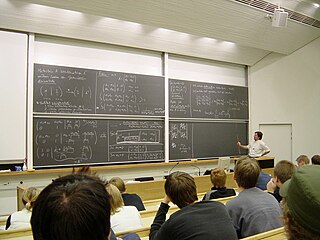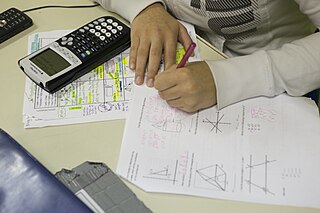Related Research Articles

In mathematics, a multiplication table is a mathematical table used to define a multiplication operation for an algebraic system.

Rote learning is a memorization technique based on repetition. The method rests on the premise that the recall of repeated material becomes faster the more one repeats it. Some of the alternatives to rote learning include meaningful learning, associative learning, spaced repetition and active learning.

In contemporary education, mathematics education—known in Europe as the didactics or pedagogy of mathematics—is the practice of teaching, learning, and carrying out scholarly research into the transfer of mathematical knowledge.

New Mathematics or New Math was a dramatic but temporary change in the way mathematics was taught in American grade schools, and to a lesser extent in European countries and elsewhere, during the 1950s–1970s.
Founded in 1920, The National Council of Teachers of Mathematics (NCTM) is a professional organization for schoolteachers of mathematics in the United States. One of its goals is to improve the standards of mathematics in education. NCTM holds annual national and regional conferences for teachers and publishes five journals.
In elementary arithmetic, a standard algorithm or method is a specific method of computation which is conventionally taught for solving particular mathematical problems. These methods vary somewhat by nation and time, but generally include exchanging, regrouping, long division, and long multiplication using a standard notation, and standard formulas for average, area, and volume. Similar methods also exist for procedures such as square root and even more sophisticated functions, but have fallen out of the general mathematics curriculum in favor of calculators.

Core-Plus Mathematics is a high school mathematics program consisting of a four-year series of print and digital student textbooks and supporting materials for teachers, developed by the Core-Plus Mathematics Project (CPMP) at Western Michigan University, with funding from the National Science Foundation. Development of the program started in 1992. The first edition, entitled Contemporary Mathematics in Context: A Unified Approach, was completed in 1995. The third edition, entitled Core-Plus Mathematics: Contemporary Mathematics in Context, was published by McGraw-Hill Education in 2015.
Traditional mathematics was the predominant method of mathematics education in the United States in the early-to-mid 20th century. This contrasts with non-traditional approaches to math education. Traditional mathematics education has been challenged by several reform movements over the last several decades, notably new math, a now largely abandoned and discredited set of alternative methods, and most recently reform or standards-based mathematics based on NCTM standards, which is federally supported and has been widely adopted, but subject to ongoing criticism.
Investigations in Numbers, Data, and Space is a K–5 mathematics curriculum, developed at TERC in Cambridge, Massachusetts, United States. The curriculum is often referred to as Investigations or simply TERC. Patterned after the NCTM standards for mathematics, it is among the most widely used of the new reform mathematics curricula. As opposed to referring to textbooks and having teachers impose methods for solving arithmetic problems, the TERC program uses a constructivist approach that encourages students to develop their own understanding of mathematics. The curriculum underwent a major revision in 2005–2007.
Education reform in the United States since the 1980s has been largely driven by the setting of academic standards for what students should know and be able to do. These standards can then be used to guide all other system components. The SBE reform movement calls for clear, measurable standards for all school students. Rather than norm-referenced rankings, a standards-based system measures each student against the concrete standard. Curriculum, assessments, and professional development are aligned to the standards.
MathLand was one of several elementary mathematics curricula that were designed around the 1989 NCTM standards. It was developed and published by Creative Publications and was initially adopted by the U.S. state of California and schools run by the US Department of Defense by the mid 1990s. Unlike curricula such as Investigations in Numbers, Data, and Space, by 2007 Mathland was no longer offered by the publisher, and has since been dropped by many early adopters. Its demise may have been, at least in part, a result of intense scrutiny by critics.
Math wars is the debate over modern mathematics education, textbooks and curricula in the United States that was triggered by the publication in 1989 of the Curriculum and Evaluation Standards for School Mathematics by the National Council of Teachers of Mathematics (NCTM) and subsequent development and widespread adoption of a new generation of mathematics curricula inspired by these standards.
Singapore math is a teaching method based on the national mathematics curriculum used for first through sixth grade in Singaporean schools. The term was coined in the United States to describe an approach originally developed in Singapore to teach students to learn and master fewer mathematical concepts at greater detail as well as having them learn these concepts using a three-step learning process: concrete, pictorial, and abstract. In the concrete step, students engage in hands-on learning experiences using physical objects which can be everyday items such as paper clips, toy blocks or math manipulates such as counting bears, link cubes and fraction discs. This is followed by drawing pictorial representations of mathematical concepts. Students then solve mathematical problems in an abstract way by using numbers and symbols.
Connected Mathematics is a comprehensive mathematics program intended for U.S. students in grades 6–8. The curriculum design, text materials for students, and supporting resources for teachers were created and have been progressively refined by the Connected Mathematics Project (CMP) at Michigan State University with advice and contributions from many mathematics teachers, curriculum developers, mathematicians, and mathematics education researchers.
Recall of facts is a value of education which is to be de-emphasized in reform of science according to new American national curriculum standards. Recall facts is often associated with rote learning.
Reform mathematics is an approach to mathematics education, particularly in North America. It is based on principles explained in 1989 by the National Council of Teachers of Mathematics (NCTM). The NCTM document Curriculum and Evaluation Standards for School Mathematics (CESSM) set forth a vision for K–12 mathematics education in the United States and Canada. The CESSM recommendations were adopted by many local- and federal-level education agencies during the 1990s. In 2000, the NCTM revised its CESSM with the publication of Principles and Standards for School Mathematics (PSSM). Like those in the first publication, the updated recommendations became the basis for many states' mathematics standards, and the method in textbooks developed by many federally-funded projects. The CESSM de-emphasised manual arithmetic in favor of students developing their own conceptual thinking and problem solving. The PSSM presents a more balanced view, but still has the same emphases.
Big Ideas Learning, LLC is an educational publisher in the United States. The company's headquarters is located in Erie, Pennsylvania. It publishes mathematics textbooks and instructional technology materials.

Mathematics education in the United States varies considerably from one state to the next, and even within a single state. However, with the adoption of the Common Core Standards in most states and the District of Columbia beginning in 2010, mathematics content across the country has moved into closer agreement for each grade level. The SAT, a standardized university entrance exam, has been reformed to better reflect the contents of the Common Core. However, many students take alternatives to the traditional pathways, including accelerated tracks. As of 2023, twenty-seven states require students to pass three math courses before graduation from high school, while seventeen states and the District of Columbia require four. A typical sequence of secondary-school courses in mathematics reads: Pre-Algebra, Algebra I, Geometry, Algebra II, Pre-calculus, and Calculus or Statistics. However, some students enroll in integrated programs while many complete high school without passing Calculus or Statistics. At the other end, counselors at competitive public or private high schools usually encourage talented and ambitious students to take Calculus regardless of future plans in order to increase their chances of getting admitted to a prestigious university and their parents enroll them in enrichment programs in mathematics.
A mathematical exercise is a routine application of algebra or other mathematics to a stated challenge. Mathematics teachers assign mathematical exercises to develop the skills of their students. Early exercises deal with addition, subtraction, multiplication, and division of integers. Extensive courses of exercises in school extend such arithmetic to rational numbers. Various approaches to geometry have based exercises on relations of angles, segments, and triangles. The topic of trigonometry gains many of its exercises from the trigonometric identities. In college mathematics exercises often depend on functions of a real variable or application of theorems. The standard exercises of calculus involve finding derivatives and integrals of specified functions.
Sybilla Beckmann is a Josiah Meigs Distinguished Teaching Professor of Mathematics, Emeritus, at the University of Georgia and a recipient of the Association for Women in Mathematics Louise Hay Award.
References
- ↑ National Council of Teachers of Mathematics. "Principles and Standards for School Mathematics" (PDF). Retrieved 2024-02-12.
- ↑ "Statement of Beliefs". Archived from the original on 2007-05-02.
- 1 2 3 "Principles and Standards - Standards 2000 Project" . Retrieved 2008-03-08.
- 1 2 "The Equity Principle" . Retrieved 2008-03-08.
- 1 2 "The Curriculum Principle" . Retrieved 2008-03-08.
- ↑ Raub, Albert N. Complete Arithmetic. Porter and Coates, 1877. See "Measurements of grain and hay" on page 313.
- ↑ "The Teaching Principle" . Retrieved 2008-03-10.
- 1 2 "The Learning Principle" . Retrieved 2008-03-10.
- 1 2 "Standards for School Mathematics: Number and Operations" . Retrieved 2008-03-10.
- 1 2 "Standards for School Mathematics: Algebra" . Retrieved 2008-03-10.
- 1 2 3 "Standards for School Mathematics: Geometry" . Retrieved 2008-03-10.
- ↑ "Standards for School Mathematics: Measurement" . Retrieved 2008-03-10.
- ↑ "Standards for School Mathematics: Data Analysis and Probability" . Retrieved 2008-03-10.
- ↑ "Feldman_Norton" . Retrieved 2008-03-10.
- 1 2 "How Do the Curriculum Focal Points Relate to Principles and Standards for School Mathematics?" . Retrieved 2008-03-24.
- ↑ Report Urges Changes in the Teaching of Math in U.S. Schools by TAMAR LEWIN New York Times September 13, 2006
- ↑ Chicago Sun Times "Fuzzy teaching ideas never added up" September 13, 2006
- ↑ "Prekindergarten" . Retrieved 2008-03-24.
- ↑ "Grade 4" . Retrieved 2008-03-24.
- ↑ "Grade 8" . Retrieved 2008-03-24.
- ↑ From the advertising materials: "Correlated to the NCTM Standards, they encourage students to understand the relationship..." "Glencoe.com eCatalog" . Retrieved 2008-03-24.
- ↑ From the advertising materials: "To address the call for “Algebra for All” from NCTM, this classroom-tested, standards-based program..." "Thinking Algebraically" . Retrieved 2008-03-24.
- ↑ From the advertising materials: "Beyond Arithmetic provides a philosophical framework that links the NCTM goals with what actually happens in classrooms..." "Beyond Arithmetic" . Retrieved 2008-03-24.
- ↑ From a brief description of the Saxon Math textbooks: "Correlated to the NCTM curriculum focal points." "saxonpublishers Product Detail" . Retrieved 2008-03-24.
- ↑ "Questions & Answers" . Retrieved 2008-03-24.